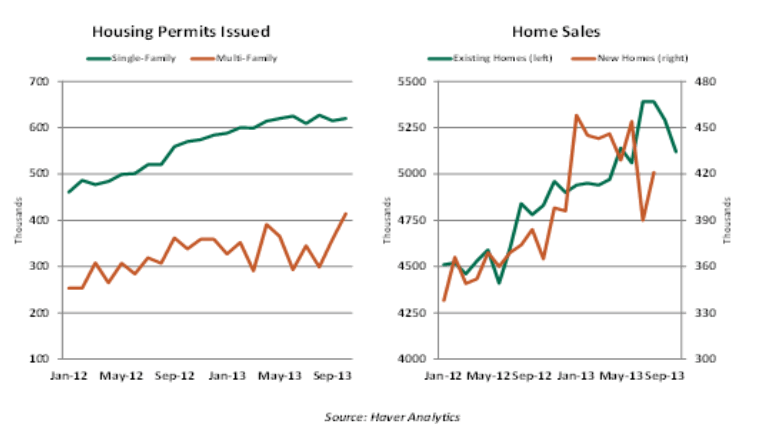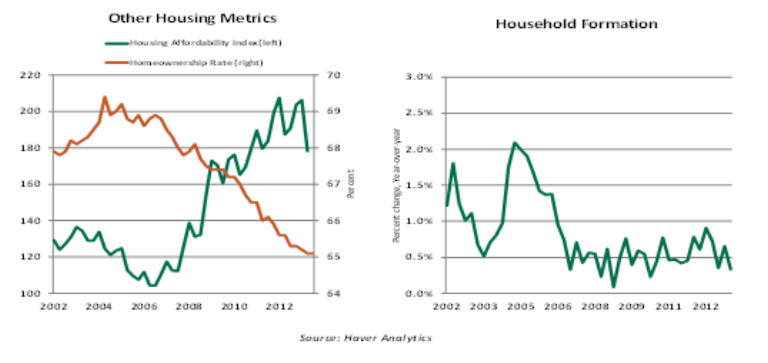U.S. Housing Market Losing Ground?
Housing-Market / US Housing Nov 28, 2013 - 09:54 AM GMT The Federal Reserve in its October policy statement viewed the housing sector as having "slowed somewhat." A quick run through the latest data confirms this diagnosis and offers some reasons for it.
The Federal Reserve in its October policy statement viewed the housing sector as having "slowed somewhat." A quick run through the latest data confirms this diagnosis and offers some reasons for it.
The partial federal government shutdown had a very pronounced impact on the publication of home sales and housing starts reports, which have been delayed for quite some time. Home sales data for September and October will be published on December 4, while housing starts numbers for September through November are scheduled for December 18.
Information on new building permits continues to come in. Permit extensions in October shot up to the highest level since 2008, largely reflecting gains in permits issued for multi-family construction. The sideways movement of permit extensions for new single-family units bodes poorly for robust construction activity. The index tracking sales of new homes in the next six months (from the National Association of Home Builders) has declined in each of the past three months.
The Pending Home Sales Index, which leads sales of existing homes by one to two months, slipped in September to the lowest level since December 2012. Sales of existing homes have dropped for two straight months, while sales of single-family existing homes are down from the levels seen in the spring.

Although mortgage rates remain very low by historical standards, the increase that followed Fed Chairman Ben Bernanke’s taper talk in May has been a major deterrent to investment in the housing sector. As a result of the jump in mortgage rates and tepid growth in income, the Housing Affordability Index has plunged sharply.

The home ownership rate continues to trend down, reflecting the adjustment process that is underway following the financial crisis. A part of this is very slow growth in household formation; 13.6% of adults ages 25 to 34 presently live with their parents, partly because of substandard job opportunities.
The Fed’s Senior Loan Officer Survey points to virtually no change in underwriting standards for mortgage lending in the past two years, implying that risk aversion in bank lending for residential mortgages persists.
Home prices present a slightly brighter picture of housing sector, with the Case-Shiller home price index recording an impressive 11.2% jump in the third quarter. The key question is whether this price trend will continue to prevail in the coming quarters.
The financial press notes that a low inventory of unsold homes in some areas is one of the reasons for the uptick in home prices. But the national data paint a different picture. The inventory of unsold new homes has moved up from a 3.9-month supply in January 2013 to a 5.0-month supply in August 2013. The total inventory of existing homes for sale in October stood close to a five-month supply, which is below the historical norm, but this number has not made significant progress in the past six months.
There may be some hope going forward. Mortgage rates have partly reversed their upward march, payroll employment picked up in October, and the average of the Mortgage Purchase Index of the Mortgage Bankers Association in the first three weeks of November exceeded the October reading. Each of these reports augurs positively for housing market activity.
But it appears that the powerful momentum that drove the American housing sector forward in the past three years may be dissipating. And it is clear that higher mortgage rates have a pronounced impact on demand. The Federal Reserve will therefore have to proceed with caution as it considers when and how to reduce its asset purchases.
Carl R. Tannenbaum
Chief Economist
http://www.northerntrust.com
Carl Tannenbaum is the Chief Economist for Northern Trust. Prior to joining Northern Trust, Carl led a team at the Federal Reserve Bank of Chicago whose charter was to analyze financial risk, its implication for the broad economy and policy choices to address it. He served as the head of the entire Federal Reserve System's risk group in Washington for a year that ended in March, working closely with Federal Reserve System Governors and senior officials.
Copyright © 2013 Carl R. Tannenbaum
The opinions expressed herein are those of the author and do not necessarily represent the views of The Northern Trust Company. The Northern Trust Company does not warrant the accuracy or completeness of information contained herein, such information is subject to change and is not intended to influence your investment decisions.
© 2005-2022 http://www.MarketOracle.co.uk - The Market Oracle is a FREE Daily Financial Markets Analysis & Forecasting online publication.



